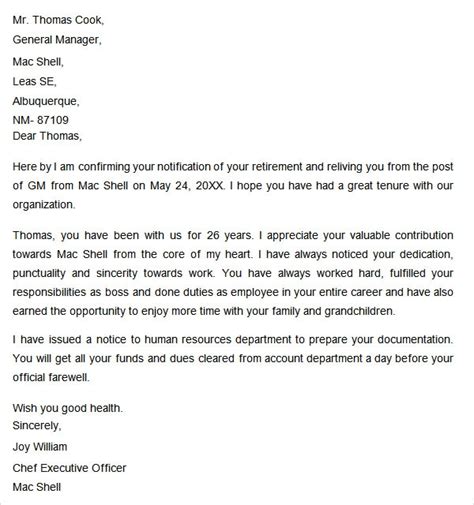Retirement Letter Template: Examples & Tips

Retirement is an important milestone in one’s life. It is a time to celebrate the years of hard work and dedication, and to look forward to a new phase in life. Writing a retirement letter is a crucial step in the retirement process, as it allows you to formally announce your retirement and express your gratitude to your colleagues and employer. In this post, we will provide you with examples and tips to help you write a retirement letter that is professional, concise, and heartfelt.
1. Choose a Format
The first step in writing a retirement letter is to choose a format. There are two main formats to choose from:
- Formal Letter: A formal letter follows a standard business format and is appropriate if you are retiring from a high-level position or a formal workplace.
- Email: An email is a more casual format and is appropriate if you are retiring from a less formal workplace or if you have a close relationship with your colleagues.
2. Address the Recipient
The next step is to address the recipient of your retirement letter. If you are writing a formal letter, address it to your supervisor or the human resources department. If you are writing an email, address it to your colleagues and supervisor.
3. Express Gratitude
Express your gratitude to your colleagues and employer for the opportunities, experiences, and friendships you have gained during your time at the company. Be specific about what you are grateful for and how it has impacted you.
4. Announce Your Retirement
Announce your retirement and state the date of your retirement. This will help your employer plan for your replacement and ensure a smooth transition.
5. Offer Assistance
If you are willing to help during the transition period, offer your assistance to your employer. This will show your dedication to the company and help ensure a smooth transition for your replacement.
6. Provide Contact Information
Provide your contact information, such as your email address or phone number, so that your colleagues can keep in touch with you after your retirement.
7. Sign Off
Sign off your retirement letter with a professional and warm closing, such as “Sincerely” or “Best regards”, followed by your name and signature.
8. Proofread Your Letter
Before sending your retirement letter, proofread it carefully to ensure that it is error-free and professional. Read it aloud to catch any mistakes or awkward phrasing.
9. Follow Up
Follow up with your colleagues and employer after sending your retirement letter. This will show your professionalism and dedication to the company.
10. Enjoy Your Retirement
Finally, enjoy your retirement! Take the time to relax, travel, pursue hobbies, and spend time with loved ones.
Conclusion
Writing a retirement letter can be a daunting task, but it is an important step in the retirement process. By following these tips and examples, you can write a retirement letter that is professional, concise, and heartfelt. Remember to express your gratitude, announce your retirement, offer assistance, provide contact information, and proofread your letter. Enjoy your retirement and the new phase of your life!
FAQs
What should I include in my retirement letter?
You should include your gratitude, announcement of retirement, assistance offer, contact information, and sign off in your retirement letter.
Should I write a formal letter or an email?
You can choose to write a formal letter or an email, depending on the formality of your workplace and your relationship with your colleagues.
When should I send my retirement letter?
You should send your retirement letter at least two weeks before your retirement date to allow your employer to plan for your replacement.
What should I do after sending my retirement letter?
You should follow up with your colleagues and employer to ensure a smooth transition and show your professionalism and dedication to the company.
How can I show my gratitude in my retirement letter?
You can show your gratitude by being specific about what you are grateful for and how it has impacted you during your time at the company.
